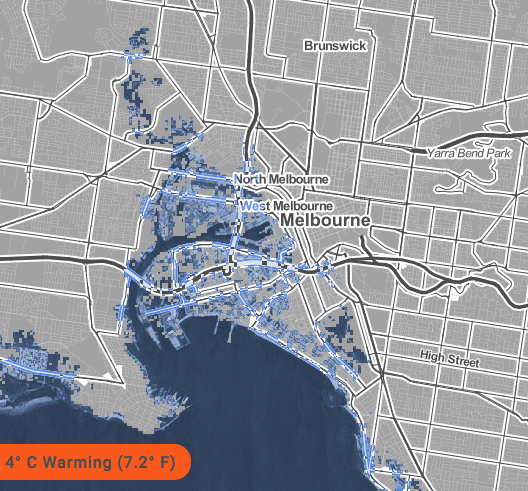Around half a billion people are at risk from sea level rise if the world continues on a business-as-usual path for carbon emissions, a new report has found – while limiting warming to the recommended 2°C would cut this risk by more than half.
The US report by Climate Central, accompanied by an online interactive mapping system, shows that carbon emissions causing 4°C of warming – what business-as-usual points toward today – could lock in enough sea level rise to submerge land currently home to 470 to 760 million people as the “unstoppable rise” unfolds over centuries.
The research also reveals, however, that aggressive carbon cuts limiting warming to 2°C could bring the number as low as 130 million people.
The report – authored by Climate Central scientists Benjamin Strauss and Scott Kulp, and Anders Levermann of the Potsdam Institute for Climate Impact Research – assesses implications for all coastal nations and cities – post-2100 – using relationships between warming caused by carbon emissions, the long-term global sea level rise it locks in, and global elevation and population data.
The news is worst for China, which is found to be most at risk with 145 million people living on land ultimately threatened by rising seas if emission levels are not reduced. Below are the mapped projections for Shanghai, at 4°C on the left, and 2°C on the right.
China also has the most to gain from strong emissions reduction, with 2°C found to cut the “at risk” total of people to 64 million. Twelve other nations each have more than 10 million people living on land at risk, led by India, Bangladesh, Vietnam, and Indonesia.
As for Australia, the report finds that 4°C warming would put 1.9 million inhabitants on land in danger, compared with 668000 at risk from 2°C.
Sydney, alone – as you can see in the selection of maps, below, of Sydney and surrounds – has 218,000 on land at risk (0.06 percent of the greater urban area population) after 4°C of warming. And 90,000 in the case of 2°C warming. Median projections of locked-in sea level rise are 8.4 meters for 4°C and 4.4 meters for 2°C.
As you can also see in the first Sydney map, Point Piper – home to the current residence of Prime Minister Malcolm Turnbull, circled in red – is in trouble either way. Although it will be someone else’s problem by then.
The Victorian coastal home of federal environment minister Greg Hunt – the Mornington Peninsula town of Mount Martha – might also be in a spot of bother, if we don’t manage to limit warming to 2°C.

As the report’s authors note, the sea level rise to realise these threats will likely unfold over 100s of years, but emissions this century can lock in one path or another.
“The global stakes of climate change are crystal clear with sea level rise,” said Benjamin Strauss, vice president for Climate Impacts at Climate Central and the lead author of the report.
“The outcome at Paris can point us toward losing countless great coastal cities and monuments around the world, unending migration, and destabilisation, or toward preserving much more of our global heritage, and a more stable future,” he said.
Levermann, co-chair of the Research Domain Sustainable Solutions at the Potsdam Institute for Climate Impact Research in Germany, added,”sea-level rise is nothing to be afraid of, because it is slow, but it is something to be worried about, because it is consuming our land, including the cities in which we create our future heritage today.”








